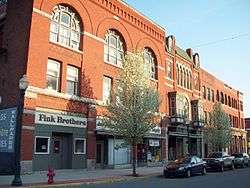
Tyrone station
Tyrone is an Amtrak railway station located approximately 15 miles northeast of Altoona, Pennsylvania on Pennsylvania Avenue south of West 10th Street in Tyrone, Pennsylvania. The station is located in the south end of the borough, and is currently only served by Amtrak's Pennsylvanian, which operates once per day in each direction.
A new railroad station building exists at the stop, but it is only currently used as a museum for the Tyrone Historical Society. There is no ticket office at this station. Due to the small number of passengers, Tyrone Station is a flag stop.
Greyhound has an intercity bus stop less than 1/4 mile north of the station, at 20 West 10th Street.
References
External links
![]() Media related to Tyrone (Amtrak station) at Wikimedia Commons
Media related to Tyrone (Amtrak station) at Wikimedia Commons

County Tyrone
County Tyrone (from Irish: Tír Eoghain, meaning "land of Eoghan") is one of the six counties of Northern Ireland. Adjoined to the south-west shore of Lough Neagh, the county covers an area of 3,155 km² (1218 sq mi) and has a population of about 177,986, with its county town being Omagh. It is also one of the thirty-two traditional counties of Ireland and is within the historic province of Ulster.
Tyrone is the eighth largest of Ireland's thirty-two counties by area and tenth largest by population. It is the second largest of Ulster's nine counties by area and fourth largest by population. The county is no longer used as an administrative division for local government purposes, but retains a strong identity in popular culture.
Name
The name Tyrone is derived from Irish Tír Eoghain, meaning "land of Eoghan", the name given to the conquests made by the Cenél nEógain from the provinces of Airgíalla and Ulaid. Historically, it was anglicised as Tirowen or Tyrowen, which are closer to the Irish pronunciation.

Tyrone, Pennsylvania
Tyrone is a borough in Blair County, Pennsylvania, 15 miles (24 km) northeast of Altoona, on the Little Juniata River. Tyrone was of considerable commercial importance in the twentieth century. It was an outlet for the Clearfield coal fields, and it was noted for the manufacture of paper products. There were planing mills, and chemical and candy factories. In 1900, 5,847 people lived here; in 1910, 7,176; and in 1940, 8,845 people resided here. The population was 5,477 at the 2010 census. It is part of the Altoona, PA Metropolitan Statistical Area. It was named for County Tyrone in Ireland.
Located along the main lines of the Norfolk Southern and Nittany and Bald Eagle railroads, and US-220, PA-453, and I-99 highways, Tyrone was at one time known as "The Hub of the Highways." In those days four railroads [Pennsylvania, Tyrone and Clearfield, Tyrone and Lock Haven, Lewisburg and Tyrone] and three main highways [US-220, PA-350, PA-453] converged there. Prior to the development of the railroads through the state, Tyrone was on the Main Line Canal, Juniata Division, of the Pennsylvania Canal system.
Tyrone (UK Parliament constituency)
Tyrone is a former UK Parliament constituency in Ireland, returning two Members of Parliament.
Boundaries and Boundary Changes
This constituency comprised the whole of County Tyrone, except the Parliamentary borough of Dungannon.
It returned two MPs 1801-1885. It was an original constituency represented in Parliament when the Union of Great Britain and Ireland was created on 1 January 1801.
In the redistribution, which took effect in 1885, County Tyrone was divided into four single-member constituencies; East Tyrone, Mid Tyrone, North Tyrone and South Tyrone.
Politics
The constituency electorate was predominantly Tory/Conservative during most of this period.
Catholics were excluded from qualifying as voters until 1793 and taking seats in Parliament until 1829 and there was a restrictive property based franchise. It was not until the electoral reforms which took effect in 1885 that most adult males became voters. See Catholic emancipation for further details.
Station
Station may refer to:
Agriculture and geography
Communications
- Amateur radio station, a station operating on frequencies allocated for ham or other non-commercial use
- Broadcasting station, a station intended for reception by the general public
- Broadcast relay station
- Earth station, a terrestrial radio station for extraplanetary telecommunication with satellites or spacecraft
- Radio station, an audio radio broadcasting station (common usage)
- Television station

Station (New Zealand agriculture)
A station, in the context of New Zealand agriculture, is a large farm dedicated to the grazing of sheep and cattle. The use of the word for the farm or farm buildings date back to the mid-nineteenth century. The owner of a station is called a runholder.
Some of the stations in the South Island have been subject to the voluntary tenure review process. As part of this process the government has been buying out all or part of the leases. Poplars Station in the Lewis Pass area was purchased in part by the government in 2003. The Nature Heritage Fund was used to purchase 4000 ha for $1.89 million. Birchwood Station was bought in 2005 to form part of the Ahuriri Conservation ParkSt James Station was purchased by the Government in 2008.
Notable stations

Station (film)
Station (駅 STATION, Eki Station) is a 1981 Japanese film directed by Yasuo Furuhata. Among many awards, it was chosen as Best Film at the Japan Academy Prize ceremony.
Cast
Reception
Awards and nominations
Podcasts:

